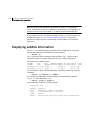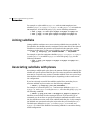
216 Creating and administering subdisks
Displaying subdisk information
Note: As for all VxVM commands, the default size unit is s, representing a
sector. Add a suffix, such as k for kilobyte,
m for megabyte or g for gigabyte, to
change the unit of size. For example, 500m would represent 500 megabytes.
If you intend to use the new subdisk to build a volume, you must associate the
subdisk with a plex (see “Associating subdisks with plexes” on page 218).
Subdisks for all plex layouts (concatenated, striped, RAID-5) are created the
same way.
Displaying subdisk information
The vxprint command displays information about VxVM objects. To display
general information for all subdisks, use this command:
# vxprint -st
The -s option specifies information about subdisks. The -t option prints a
single-line output record that depends on the type of object being listed.
The following is example output:
SD NAME PLEX DISK DISKOFFS LENGTH [COL/]OFF DEVICE MODE
SV NAME PLEX VOLNAME NVOLLAYR LENGTH [COL/]OFF AM/NM MODE
sd mydg01-01 vol1-01 mydg01 0 102400 0 c2t0d1 ENA
sd mydg02-01 vol2-01 mydg02 0 102400 0 c2t1d1 ENA
You can display complete information about a particular subdisk by using this
command:
# vxprint [-g diskgroup] -l subdisk
For example, the following command displays all information for subdisk
mydg02-01 in the disk group, mydg:
# vxprint -g mydg -l mydg02-01
This command provides the following output:
Disk group: mydg
Subdisk: mydg02-01
info: disk=mydg02 offset=0 len=205632
assoc: vol=mvol plex=mvol-02 (offset=0)
flags: enabled
device: device=c2t1d1 path=/dev/vx/dmp/c2t1d1 diskdev=32/68


















